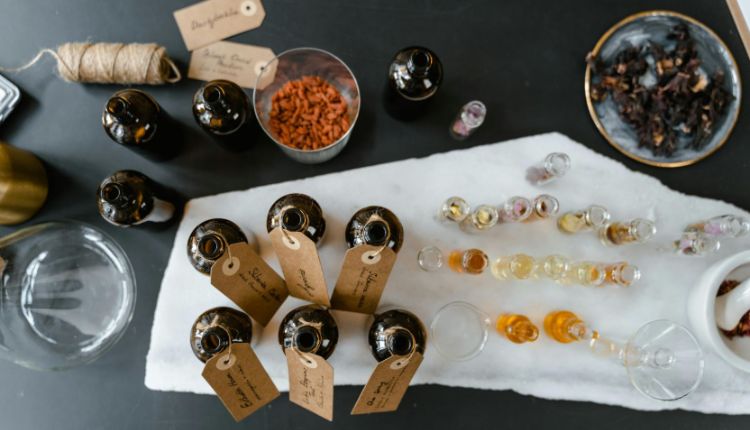
Perfume
The craft of perfume-making is an elegant blend of artistry, scientific precision, and a keen insight into human emotions. It’s a journey from an ethereal concept to a tangible, aromatic experience that captivates and enchants the senses. This article unveils the intricate process behind perfume creation, tracing the path from the first inspiration to the final product encased in a bottle.
The Genesis of a Fragrance: The Concept Phase
Every perfume begins with a vision, sparked by an array of emotions, the natural world, or cherished memories. Perfumers, often referred to as ‘noses’, initiate this process by pinpointing the fragrance’s intended effect. Whether it aims to capture the zest of spring or the comfort of a winter evening, this vision lays the groundwork for all subsequent creative decisions.
Sourcing Ingredients: The Building Blocks of Perfume
Following the conceptualization, the quest for perfect ingredients commences. These elements are the backbone of any fragrance, sourced globally from nature and synthesized in labs to craft a distinctive olfactory profile. Each component is meticulously selected for its aromatic properties and its harmony with the fragrance’s overarching theme.
The Art of Blending: Crafting the Scent
The blending process is where theoretical chemistry transitions into sensory art. Guided by seasoned perfumers, the selected ingredients are combined in exact proportions. This crucial phase demands a profound understanding of the interaction between various notes—from the initial top notes to the rich base notes that anchor the fragrance, providing longevity and depth.
Refinement and Maturation
After the initial blend, the perfume enters a maturation phase. This period, extending from weeks to months, is vital for the scent’s evolution, as the ingredients undergo chemical transformations that enhance their harmony and smoothness.
Testing and Tweaking
After maturation, extensive testing begins to ensure the perfume performs well on the skin, maintaining its integrity over time. This stage might prompt further refinements to perfect the fragrance based on real-world feedback and sensory analysis.
Designing the Bottle: The Final Touch
The bottle’s design is as crucial as the fragrance it houses. It must reflect the perfume’s spirit and essence visually and functionally. The collaborative efforts between designers and the perfumery team aim to produce a vessel that not only protects the fragrance but also complements its identity, merging practicality with artistic expression.Here’s an insightful look into innovative bottle designs.
Filling and Packaging
In the final stages, meticulous attention turns to filling and packaging, preserving the fragrance’s integrity up to its arrival in consumers’ hands. The perfume is encased and prepared for distribution, ensuring each package is secure and visually appealing, ready to enchant its recipient.
The Role of Subscriptions in Perfume Discovery
The modern consumer’s penchant for customization has bolstered the popularity of subscription services. Such services, like a cologne monthly subscription, provide a gateway to explore a plethora of fragrances periodically. This approach allows both connoisseurs and novices to immerse themselves in a diverse world of scents without a long-term commitment, enriching their olfactory journey.
The Psychological Impact of Fragrance
Perfume does more than just smell pleasant; it has the power to evoke emotions and memories, making it a powerful tool for psychological well-being. Scents can transport us to different places and times, trigger memories, and even alter our mood. Perfumers must consider the emotional impact of each fragrance, crafting scents that not only create an immediate impression but also leave a lasting emotional resonance with the wearer.
The Role of Technology in Perfume Development
Advancements in technology have revolutionized the perfume industry, from the way ingredients are extracted to how fragrances are tested. Modern techniques like headspace technology allow perfumers to capture the essence of materials that are impossible to extract by traditional methods. Moreover, artificial intelligence is now used to predict how different aromas will combine, speeding up the development process and enabling more complex fragrance creations.
Sustainability in Perfume Production
As consumers become more environmentally conscious, sustainability has become increasingly important in the perfume industry. Perfumers are turning to ethically sourced ingredients and eco-friendly production methods to reduce environmental impact. This shift not only appeals to the eco-conscious consumer but also helps preserve the natural resources that are vital to the industry.
Cultural Influences in Perfume Creation
Perfume is a reflection of cultural identity and practices, with each culture bringing its unique sensibilities and ingredients to the table. For instance, Middle Eastern perfumes traditionally feature-rich, opulent scents like oud and amber, which are ingrained in the regional culture. Understanding these cultural nuances is crucial for perfumers aiming to create fragrances that resonate on a global scale.
Future Trends in Fragrance
The future of perfume is likely to see even more personalization and innovation. With the rise of niche perfumeries and artisanal creators, consumers are increasingly seeking out unique, customized scents that stand apart from mainstream offerings. Additionally, the integration of virtual reality in perfume shopping could transform how consumers discover and experience fragrances, making it an even more immersive and personalized process.
Collaboration in the Perfume Industry
The creation of a new fragrance often involves collaboration between perfumers, fragrance designers, and even celebrities or fashion brands. These partnerships can bring different perspectives and new ideas to the table, enriching the creative process. By combining various artistic visions, the perfume industry continues to innovate and produce captivating scents that appeal to a broad audience. These collaborations can also help bridge the gap between different artistic disciplines, creating a more interconnected creative industry.
Educational Aspects of Perfumery
Perfumery is not only an art but also a science that requires extensive knowledge and training. Aspiring perfumers often undergo rigorous education in chemistry and fragrance composition at specialized schools around the world. These institutions not only teach the technical skills needed to create complex fragrances but also provide a historical and cultural context, which is crucial for creating perfumes that resonate with consumers. Furthermore, continuous learning is a staple in a perfumer’s career, as the field is always evolving with new techniques and materials.
Ethical Considerations in Sourcing Ingredients
Ethical sourcing has become a significant focus in the perfume industry. Perfumers and brands are increasingly committed to ensuring that the ingredients used in their fragrances are obtained responsibly. This includes not only environmental considerations but also social factors, such as fair labor practices and community support. Consumers are becoming more aware of the origins of the products they use and are demanding transparency and responsibility from brands. This shift towards ethical sourcing helps to ensure the long-term sustainability of perfume resources and supports the communities involved in the production process.





